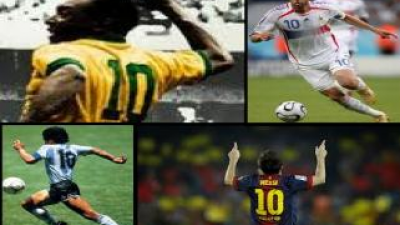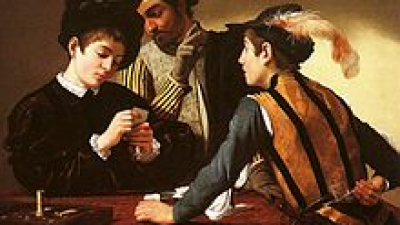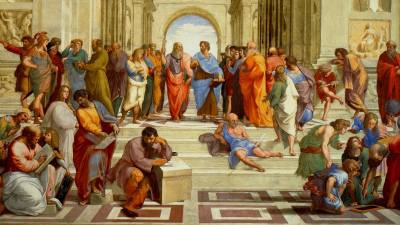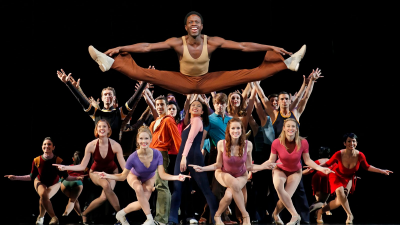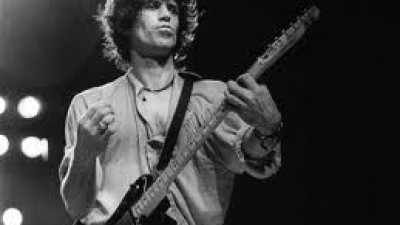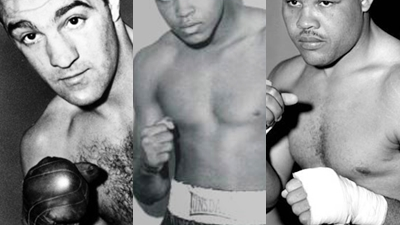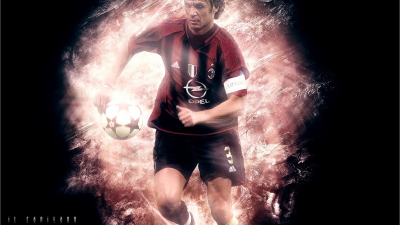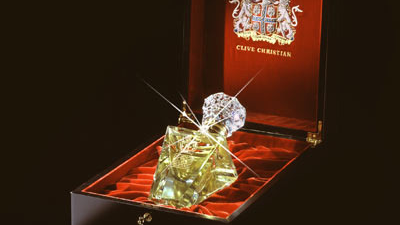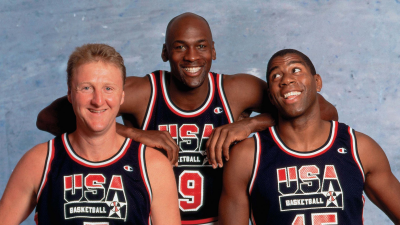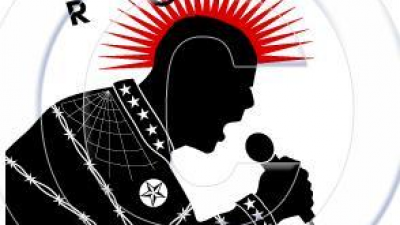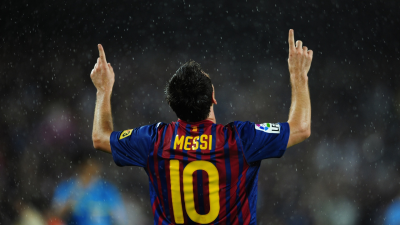The best Costa Rican strikers in history
|
SPORT
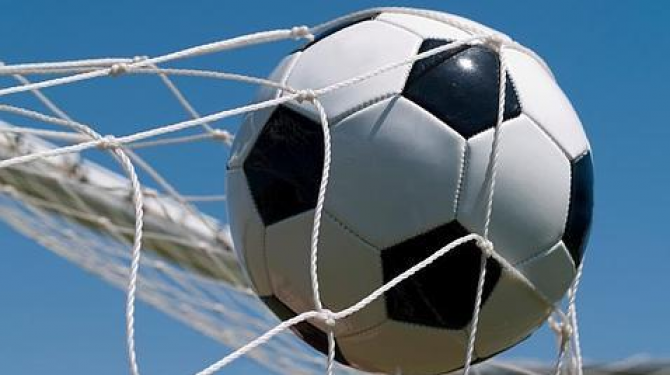
Source: listas.20minutos.es
Best strikers in Costa Rica.
TOP 37:
Joaquín Manuel Toquita Gutiérrez
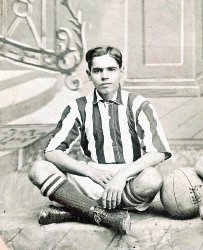
Joaquín Manuel Toquita Gutiérrez entered history. He made the first goal of the Tricolor, in 1921.
TOP 36:
Hernán Bolaños Ulloa
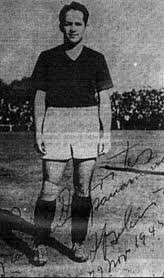
He was a Nicaraguan footballer who played as a professional in the First Division of Costa Rica and in the First Division of Chile. In addition, he played official matches as a member of the national teams of Costa Rica and Chile. In Costa Rica, he was always valued as a player full of courage and decision, becoming part of teams such as Orión FC, University of Costa Rica UCR and Alajuelense Sports League in a squad that brought together figures like Alejandro Morera Soto. He was a leading striker in the Costa Rican national soccer team, and between 1947 - 1948 he acted as coach. In the second half of the thirties he was hired to play with Chilean teams such as Audax Italiano and Universidad Católica, he even joined the Chilean national soccer team between 1940-1941, touring many countries on the continent.
TOP 35:
Alberto "Gallego" Armijo Pujol
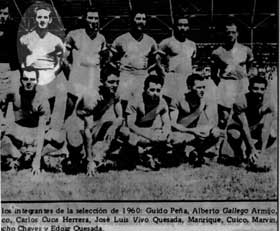
He was born on September 27, 1926 in Nicoya, Guanacaste, played soccer with Orion, University of Costa Rica, Spanish Gymnastics, Club Sport La Libertad and Club Sport Cartaginés. And in basketball with Seminario EL and Orión; He also reinforced La Libertad and Gimnástica. In basketball, he participated in the Central American and Caribbean Games in Barranquilla, Colombia (1946) and international matches against Poza Rica of Mexico, Lord Chesterfield of Panama and the University of Havana. And in soccer, he was in the Central American and Caribbean Soccer Championships (1948 and 1960), the Central American and Caribbean Games (1950), the Pan American Games in Buenos Aires, Argentina (1951), and the Pan American Soccer Tournament in the country (1960). With the Major he scored six goals in 16 international games. Achievements: Silver medal in the Pan American Games of Argentina (1951) and Central American and Caribbean monarch of football (1948 and 1960). Three times champion with the National Champion Seminar of the First Division, undefeated, with the Orion (1944). National scorer in 1950, with the University of Costa Rica (25 goals), and in 1960, with the Carthaginian (16 goals). Member of the Costa Rican Sports Gallery, in 1986.
TOP 34:
Guido Peña Pol
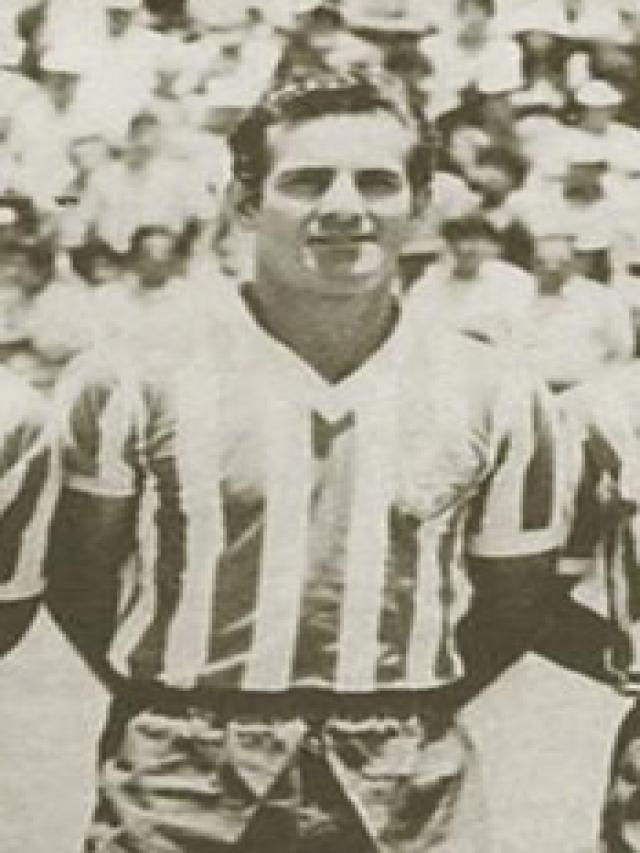
It is part of the Club of the 100 players who scored more than 100 goals in the First Division of Costa Rica. He began his sports career in the minor leagues of Orion FC, club with which he would make his debut in the First Division of Costa Rica on November 23, 1955, in a meeting before the Moravia Sports Union, where he would score his first two scores in the highest category. Later he would be linked to the Herediano Sport Club in 1961, the same year with which he would be proclaimed champion with the Florians of the 1961 tournament.4 In 1962 he joined the Rohmoser Sports Association but only for one season, since that year they would achieve the descent to the Second Costa Rica Division. The following year he would return to Orión FC, a team with which he would get the runner-up in the 1964 season. He played his last season with the Carthaginian Sport Club, where a knee injury forced him to retire in 1972. He records a total of 125 goals Officers in local tournaments. At the national team level he participated at the youth level of the Central American Championship in 1954, where he won the championship. His debut with the senior team made it to Uruguay on December 8, 1959. In addition, he played the qualifiers for the 1966 Soccer World Cup, as well as the NORCECA held in Guatemala. He scored eight goals in 12 class A matches. The highest individual distinction is his incorporation to the Costa Rican Sports Gallery in 1993.
TOP 33:
Danilo Montero Campos
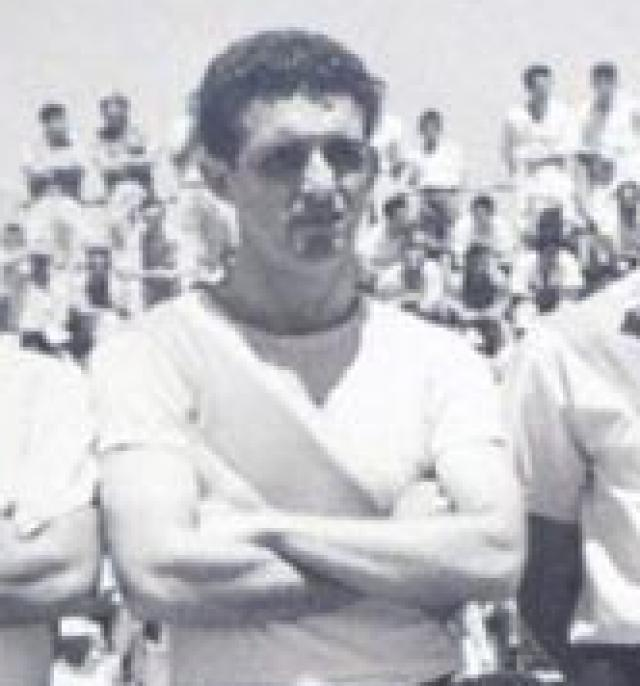
He began his career in 1947 in the minor leagues of the Moravia Sports Union. From 1950 to 1959 he was a member of the Herediano Sport Club, a team with which he made his debut in the First Division of Costa Rica on June 13, 1954 in a match against Orion FC. In his first stage with the Floridians he would be proclaimed champion of the 1955 tournament. In 1959 he would be linked to the Italian Audax of the First Division of Chile, and later to the Sevilla Football Club in Spain in 1961. He would return to the Heredian Sport Club that same year where he would obtain the title of champion of the 1961 championship, the same year he retires from professional football. From 1962 to 1966 he participated in amateur football in the United States as a player of Deportivo Costa Rica and Saint Stevens. At the national team level he played in 16 international class A games, in which he scored three goals. He was champion of the Central American Championship of 1955 and a member of the famous group of the Golden Chaparritos, which took third place in the Pan American Football Championship in 1956. The highest individual distinction is his incorporation to the Costa Rican Sports Gallery in 1991.
TOP 32:
Rafael Ángel "Macho" Madrigal
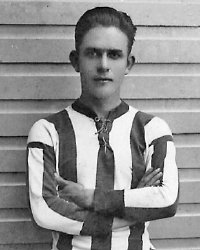
Rafael Ángel 'Macho' Madrigal, a scorer feared in the 20s and 30s, will always be engraved in the golden football books. His contribution 92 years ago, in 1921, he was as the first scorer of a goal in the Tico Championship of the First Division.
TOP 31:
Jorge Dávila Sibaja
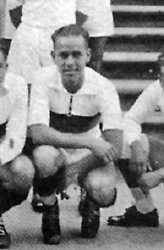
He was born on March 22, 1916, in San José. Forward with Orion, La Libertad, Spanish (Spain), Olympique de Paris (France) and Centro Gallego y Universidad (Cuba). Selected in 1935. Dentist. With 90 years he lives in Tibás.
TOP 30:
Rubén "Rat" Jiménez
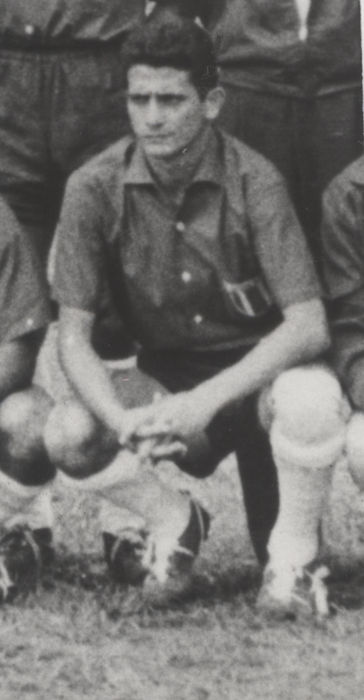
Rubén Jiménez scored the goal of Saprissa for the Gold of Mexico, in 1963. He was one of the famous 'Chaparritos de Oro' in the Costa Rican National Team of 1956.
TOP 29:
Leonidas Flores Reyes
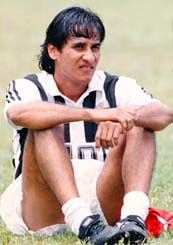
He is a retired soccer player. Juice for AD Municipal Puntarenas, Deportivo Saprissa, AD Guanacaste and AD San Carlos as striker. Flores won the 1986 Costa Rica Soccer Championship with the Municipal Puntarenas, accompanied by other great figures of the time such as: Alfredo Contreras, Gilberto Rhoden, Kleber Ponce, Carlos Velasquez and others. With 93 goals he is the top scorer in the history of this club. Flores had 30 appearances for the Costa Rican Soccer Team between 1984 and 1996. He participated in the 1984 Los Angeles Olympics in two games, both as a substitute. Flores was part of the selection that participated in the 1989 Concacaf Championship, which Costa Rica won and qualified for the 1990 Italy World Cup. It should be noted that in this championship he scored 2 key goals against El Salvador at Cuscatlan Stadium and charged the free kick where Pastor Fernandez would score the goal of the classification. In the absence of 2 months for the World Cup, the new coach Bora Milutinović discarded him from the team, as did 7 other figures who participated in the process. He would also participate in the 1991 Uncaf Cup and 19914 Concacaf Gold Cup with the Costa Rican national team.
TOP 28:
Alexis Goñi Fonseca
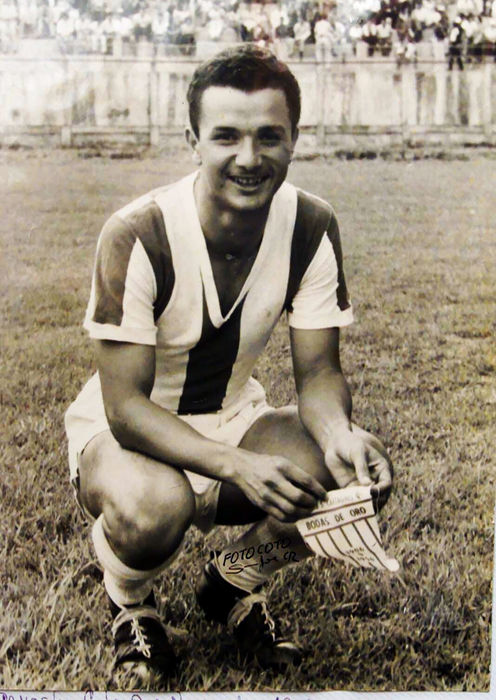
It started at the San Luis Gonzaga College football school in Carthage, and then went to the minor leagues of the Carthaginian (mosco, children, youth and third division). In the First Division, he stood out as the far left of the Carthaginian, for 11 years. Several injuries forced him to retirement in 1960, although he returned to play two years in Second with Nicolás Marín and one in First with Turrialba, in 1965. He reinforced all local clubs for international games, with the particularity that he scored with Saprissa, Herediano, Uruguay and Alajuelense (headed the winning goal, 2-1, against the Austrian FK). He received offers from Mexican clubs (Irapuato, Laguna and Toluca), but did not travel when he did not receive permission from the Carthaginian board. 65 goals scored in the First Costa Rican Division, according to Gerardo Coto Cover, coordinator of the History and Statistics Commission of Unafut. He made 63 with the Carthaginian, which made him the third best scorer in misty history. He added 87 points in his career, including championships, cup tournaments, national team and interclub games. His debut was on March 10, 1953, against Panama (Sele won 3-0), at the National Stadium, for the Central American and Caribbean Football Championship. Since then and until his retirement, he played six games and scored two goals, between 1953 and 1956. He won undefeated the aforementioned Central American and Caribbean, in 1953, and was a figure with the National Team known as the Golden Chaparritos, which ranked third in the II Pan-American Soccer of Mexico, in 1956.
TOP 27:
Edwin Cubero
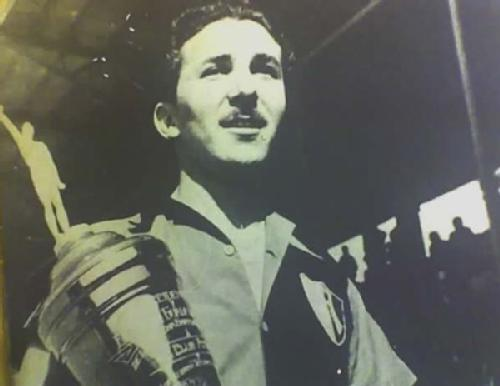
He was a Costa Rican professional soccer player who played for several clubs in Costa Rica and Mexico, enjoying his greatest success with the Atlas. Cubero is the all-time leading scorer of Atlas and was an important part of the club during the 1950/51 season, his only season, winner of the championship. In March 2000, Cubero died of kidney failure in Guadalajara, Mexico.
TOP 26:
Winston Antonio Parks Tifet
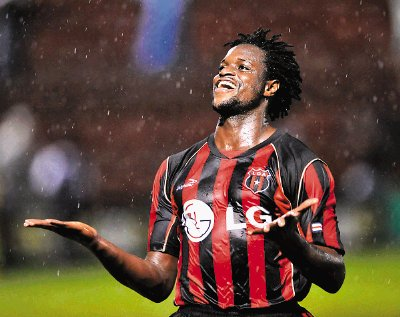
Winston Antonio Parks Tifet (Limón, Province of Limón, Costa Rica, October 21, 1981) is a Costa Rican footballer. He plays forward and his current team is the ADF Siquirres of the Second Division of Costa Rica. He has been international with the Costa Rica Soccer Team, with which he debuted in November 2001. He had previously played in the lower categories. He participated in the Youth Soccer World Cup 1999 and 2001; In the latter he scored four goals.
TOP 25:
Roy Sáenz Acuña
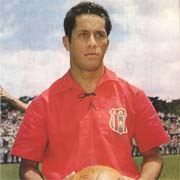
His name is synonymous with goal, that is why in Liga Deportiva Alajuelense he will always be remembered for the delivery and annotations with the shirt manuda. Limón saw him born in 1944, Barrio México marked the beginning of his football life and Liga Deportiva Alajuelense witnessed the consolidation of his career on the courts, until he became the third historical scorer of national football, accounting for 168 goals.
TOP 24:
Salvador Soto Villegas "The Indian Buroy"

He was a former Costa Rican soccer player and technician. He became the first soccer player to play a World Cup qualifying phase. While performing in Cuban clubs in Havana (first with Fortuna and then with the Galician Center), he accepted the local proposal to play with Cuba in the previous regional round towards the 1934 meeting. He first disqualified Haiti (3-1, 1 -1 and 6-0), but then succumbed in the next series to Mexico (2-3, 0-5 and 1-4). He is also remembered for winning four titles as coach of the Alajuelense Sports League. He served as the left wing of Alajuelense, several times between 1926 and 1949, which was the year of his retirement. He also did it with Fortuna (1931 to 1933) and Centro Gallego (1934), Cuba; and with Spain (1936) and Moctezuma de Orizaba, Mexico (1937-38). He reinforced several clubs on tours of Central America, Mexico, Cuba, Peru, Colombia and Ecuador. He played with Costa Rica in 1930, 1938 and 1946, to score five goals in 12 international games. And he acted with Cuba in the 1934 World Cup qualifier against Haiti and Mexico.
TOP 23:
Walford "Wally" Vaughns
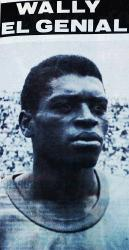
Walford (Wally) Vaughns, that extraordinary extreme right of Carthaginian and national football between 1964 and 1978. Living in Guácimo, where he left alone by train, came to play with Guápiles a preliminary match that faced Turrialba and Carthaginés. Those of the latter team kept an eye on him, and invited him to come and test Carthage. To do this, Wally first had to ask permission from the National Production Council for whom he worked in Guácimo. He took the train at 6.30 am, arrived in Carthage at 11 am, trained two hours and at 1.30 pm again by train to Guácimo, where he arrived at 6 pm He sacrificed for what he liked, which gave him great successes in the football world and in his personal and professional life.
TOP 22:
Carlos Solano
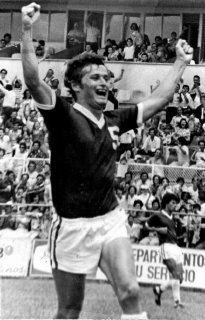
Carlos Solano is considered one of Costa Rica's best soccer strikers during the 1970s. He played most of his career at Deportivo Saprissa. Solano helped Saprissa won several national titles during the 1970s, becoming one of the best scorers of the mythical Saprissa team that won six consecutive national championships during 1972-1977, and was the top scorer in the 1976 national tournament, scoring a total of 49 goals during those six seasons. He played with the Costa Rica Soccer Team as well.
TOP 21:
Rodolfo Herrera González
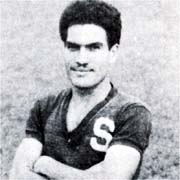
Rodolfo Herrera González, in the decade of the 50s, and even were forced to pick up balls from the bottom of their goals, in friendly against Saprissa and the selected Ethnic. Rodolfo's first steps were with Deportivo Fernando Montealegre de Guadalupe, at the beginning of the 40s. From there he jumped at the Saprissa children's hand by the club's founder, Roberto Beto Fernández, in 1943. Herrera converted 141 goals with Saprissa .
TOP 20:
Leonel Hernández Valerín
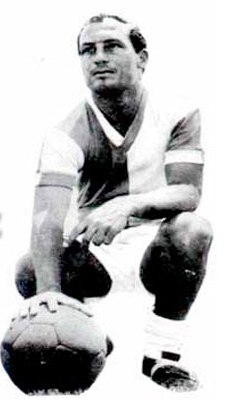
The elegance and magic that had his left leg, his strong shots and his impeccable charges from the corner or at the start of a free kick, plus his genius as the left end of the Carthaginian between 1960 and 1979 made him gain a place in everyone's mind The followers of good football. Called correctly as the "Billiards of Soccer", Leonel Hernández Valerín can not only claim to be the top scorer in the history of the dean of the first division, but is also the player who played the most matches with the blue and white shirt. With 360 games in tow since his debut against Herediano in 1960, until his retirement in 1979, Hernández stood out in the famous “Blue Ballet” that gave fame to the Carthaginian between 1965 and 1977, that misty squad that marveled the country thanks to his football elegant and colorful which was also a scoring machine that also had the talent of other great legendary club such as Walford "Wally" Vaunghs, Rigoberto Rojas, Enrique "Pelirrojo" Córdoba, Asdrúbal Meneses and many more that made Carthaginian famous , which unfortunately was not rewarded with being a national champion at that time. After several days of investigation, the famous "Billiards" is confirmed as the Carthaginian with more games in history followed by two other players who gave much of their lives to the club of their loves. This is Miguel Calvo who even helped the team in his promotion to the highest category in 1984 as well as Marco Tulio Hidalgo who could have achieved more success in this record; However, it was prevented from passing through Sagrada Familia and San Carlos in some seasons, despite this, the mark of both was in 329 games, a record also difficult to match.
TOP 19:
Jorge Hernán "Cuty" Monge
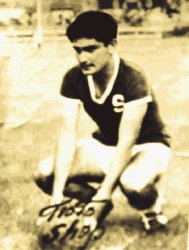
He is remembered for holding the record for the highest number of scores in a single match in the First Division of Costa Rica; since he scored 6 goals to the La Libertad Club Sport team, acting for Deportivo Saprissa in 1958. In addition to being a fundamental piece in the historic team of the Golden Chaparritos of the Costa Rican Section in the 50's and 60's . He entered the children of Saprissa in 1951, and contributed to the achievement of that year's championship. It was also the year of his first international match against the Pipiles of El Salvador. In this, held on December 25, where he scored 3 goals to complete the final score of 5 to 1, in favor of the Costa Rican team. With only 15 years, in 1953, Cuty became one of the youngest players to reach the First Division, thanks to the call made by coach Pachico García, of the purple team, by virtue of the need to strengthen the team , since the Saprissistas contributed the majority of the players of the National Selection. From that moment on, he began a 15-year career with the Purple Currency, which would lead him to be considered one of the best front centers that Costa Rican football has had, and which places him among the top scorers in national football. In his extensive record of successes, Cuty has 6 National Championships in: 1953,1957, 1962, 1964, 1965 and 1967 and 6 Runners-up in: 1955, 1958, 1959, 1961, 1963 and 1966. He holds the record, still in force, of the highest number of entries in a single match; since on May 18, 1958, he scored 6 of the 7 goals with which Deportivo Saprissa beat the team of Club Sport La Libertad. He was also a participant in the biggest win recorded by Saprissa in its history. This event took place on November 2, 1955, in a match held against the Moravia Sports Union. The score was 10 goals to 0, of which Cuty scored 5. During the 1962 Championship, this great player took the title of Goleador Champion. For having scored 12 goals. It was also declared as the best Front Center of the Decade of 1950-1959, through a survey conducted by the newspaper La Nación, a group of former soccer players, technicians, leaders, journalists and athletes. He retired from the courts after winning the 1967 Championship following a car accident that caused several injuries.
TOP 18:
Edgar Marín Leví
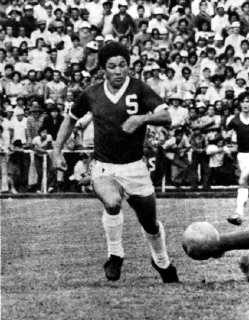
Between 1967 and 1969, Marín played in Deportivo Saprissa, as well as in the NASL for the Oakland Clippers and Kansas City Spurs. He also played for PEC Zwolle in the Netherlands. Marín won 12 Costa Rica First Division titles with Deportivo Saprissa during the 1960s and 1970s. He won six consecutive titles from 1972 to 1977. Marín also represented Costa Rica in the international arena.
TOP 17:
Claudio Miguel Jara Granados
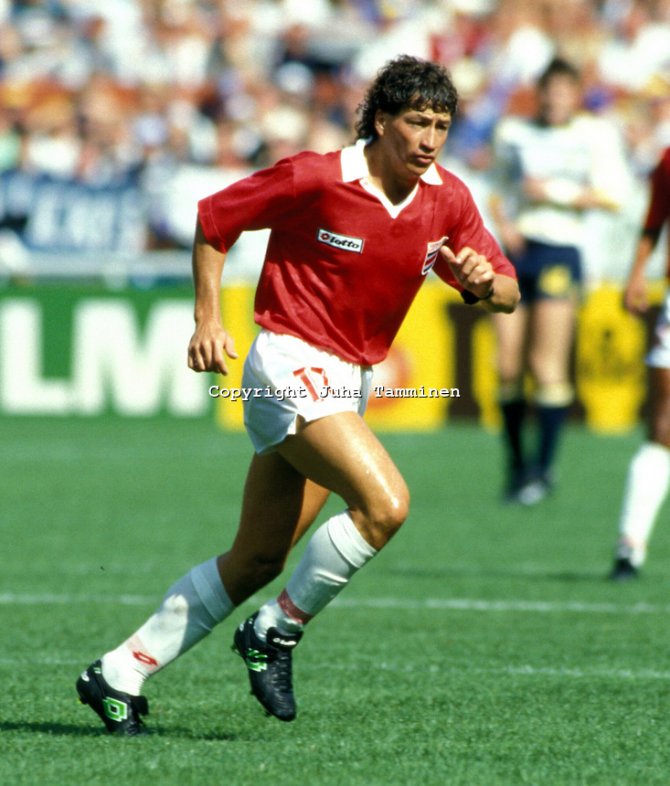
He began his sports career at the Club Sport Herediano, making his debut in the First Division of Costa Rica in 1982. With Floridians he won the title of champion in the 1985 and 1987 seasons, in addition to becoming the top historical scorer of the institution when reaching 99 goless. Apart from Herediano, he played with the Alajuelense Sports League between 1992 and 1994, the Guanacasteca Sports Association between 1995 and 1996, and the Carmelite Sports Association in 1996, as well as the Bucaramanga Athletic Club of Colombia in 1994 and the Alliance Club of El Salvador in 1995 He retired from football after suffering a serious knee injury in 1996. He scored 129 goals in the First Division of Costa Rica. At the national team levels he participated in the 1990 Soccer World Cup, 1991 Uncaf Cup and 1991 Concacaf Gold Cup totaling 11 goals in 46 Class A matches. He played his last international match on December 17, 1994 against Selection of soccer of Saudi Arabia. As a coach, he has directed the U-20 National Team of Costa Rica as a technical assistant in 2003, the Sagrada Familia Sports Association in 2010 and the Herediano Sport Club in 2012, a team with which he won the Winter 2012 runner-up. He has also been to in charge of different sports projects and soccer schools. His top individual distinctions have been the goalscorer titles with the Herediano Sport Club in the 1987 season and with the Costa Rica Soccer Team in the 1991 Uncaf Cup.
TOP 16:
Victor "The Mambo" Núñez Rodríguez
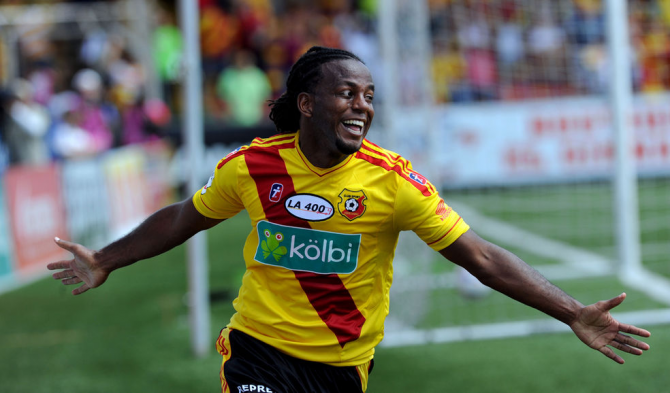
He is currently the best historic scorer4 of the First Division of Costa Rica with a total of 205 scores and counting. He began his career with the Saprissa Sports team, making his official debut5 in the First Division of Costa Rica on December 16, 1999 in a meeting against the Municipal Goicoechea. In his first stage with Deportivo Saprissa he does not achieve any annotation, so he would be loaned to the Limonense Sports Association in 2000, having an outstanding participation with 20 goals in 31 games (his first score in Costa Rica's First Division he would achieve it with the Limonense team on October 12, 2000 in a match against the Alajuelense Sports League). Later, he would join the Santa Bárbara Sports Association in 2001 as a loan, where he would continue his good scoring streak, reaching 17 goals in 18 games. He would return to Deportivo Saprissa in the 2002 season, where on this occasion he would have more participation and achieve the figure of 9 goals. In 2003 he became part of the Alajuelense Sports League team, a team with which he would win the 2004 Concacaf Champions Cup. In this first step with the alajuelense team he manages to score 10 goals. Again he would be loaned, on this occasion to the Carthaginian Sport Club, a team with which he stayed between the seasons of 2004 - 2006, where he became the best scorer of the 2005 Opening Tournament with 10 scores (in his step with the misty achieves a total of 29 scores in 53 games). He returns to the Alajuelense Sports League in 2006, a club with which he would achieve the title of top scorer of Winter 20077. In his second step with the manudos, he achieves the figure of 28 goals. In 2008, he linked up with the Liberia Mía team, a club with which he would continue to achieve triumphs, once again being the top scorer of the First Division in the 2008 and Winter 2009 tournaments. Later he would be the champion of the 2009 Summer tournament. to Club Sport Herediano8 in the year 2010, team with which he militates until today. With the Floridians he reaches the titles of champion of Summer 2012 and Summer 2013, where he has also obtained the runners-up of Winter 2010, Winter 2011, Winter 2012 and Winter 2013. In Summer 2013 he was proclaimed champion of the tournament with 12 scores, being in turn, the fourth occasion in which he obtains this distinction in his sports career. On November 17, 2013 he obtains the mark of the best historic scorer of the First Division of Costa Rica by scoring a double against Limón Fútbol Club, with which the record is awarded by reaching 198 goals, surpassing the former Alajuelense Errol Sports League player Daniels who had this brand since 1970 with 196 entries. On November 20, 2013, it marks a milestone at the national level when it reaches, again with a double, the mark of 200 goals in the First Division of Costa Rica. At national team levels he has had a total of 18 appearances, scoring six times. He participated in the 2010 FIFA World Cup Qualifying (Concacaf), in the 2011 Central American Cup, as well as the team that played the 20069 World Cup, however, he had no participation in that cup.
TOP 15:
Oscar "Cuico" Bejarano
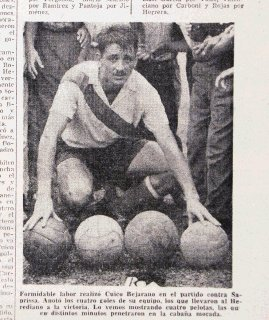
TOP 14:
Juan Ulloa Ramírez
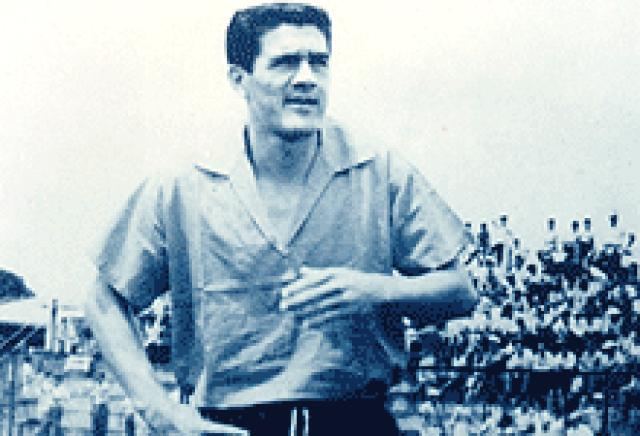
Juan Ulloa Ramírez was born to play football. No one disputes that, and in football he was born to score goals. From an early age, the different open courts of Alajuela observed the figure of that young man who captured the attention of his own and strangers, for his innate ease of doubling rival defenses and scoring many, but many goals. He was hired by the Alajuelense Sports League on August 9, 1954, being the president of the Club, Mr. Evelio Martínez. The League bought the rights of players Juan Ulloa Ramírez and Luis Alberto "Checas" Alvarez from the Carmelita team, for which ¢ 500 was paid for each. He was only 16 years old when at the end of 1954 he debuted in the first division with the League. He played as center forward and the final score was 5 - 0 in favor of the red and black. In the year 55 he was called to be part of the National Team that participated in the "Central American and Caribbean Championship" held in Honduras. During the next six years, Juan Ulloa would be immovable piece of our Selection. In the Central American Championship held in Havana, Cuba, Ulloa was the top scorer with 4 goals. During the world tour of the League, in 1960, this fearsome striker became a champion scorer of the same to get 24 scores. A year earlier, in 1959, he was a goal scorer of the national tournament with 17 conquests and added 15 more goals in 60, during the local championship. 1961 arrives and the Central American and Caribbean Championship is held here in Costa Rica. Ulloa is the scorer of the contest with 10 scores. In 1966 he dressed in Sancarleño colors and managed to share the maximum goal with another giant, Errol Daniels, both made 30 entries each. His last match with the Alajuelense Sports League was in 1970, playing against Carthaginian at the Fello Meza Stadium.
TOP 13:
Froylán Greing Ledezma Stevens
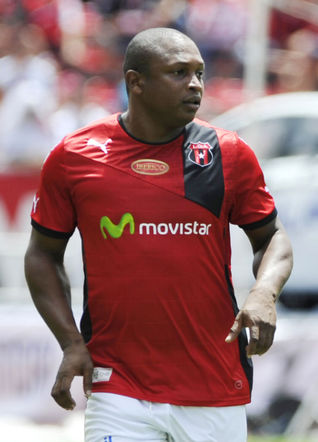
He is a former Costa Rican soccer player, retired whose career was linked to the Alajuelense Sports League team and several international clubs in Germany, Austria, Greece, Bolivia, Paraguay and even the Ajax of Holland. His nickname is "The Puppy." He debuted in the Alajuelense Sports League at the age of 18. In the 1995/96 season he scored 14 goals and played 41 games, and in the following season he scored 21 goals in 27 games. The Dutch club Ajax Amsterdam signed him in 1997 for around 4.5 million euros, however, the young promise was not a success in Dutch football. He was suspended by Ajax after his first season until his contract ended (almost three years later). He signed for Cerro Porteño. Later, he returned to Costa Rica, where he signed with Deportivo Saprissa (archdival of Alajuelense). After Saprissa played in Bolivia with The Strongest, it soon became an important piece of the initial lineup, playing the Copa Libertadores. He then returned to LD Alajuelense and became champion of the CONCACAF Champions Cup of 2004. Ledezma became a fundamental part of the initial lineup and took his team to the league championship in the 2004/05 season. He played the 2005-06 season with Alajuelense, but was ceded to the Greek team Akratitos for 6 months (1/1 / 2006-30 / 6/2006), and then was bought by the Austrian SC SC Rheindorf Altach. He made an acceptable campaign and at the end of the season was sold again to FC Augsburg. In a quick operation he was transferred to VfB Admira Wacker Mödling. In 2009, after a poor performance of the national team of Costa Rica under the direction of Hernán Medford, the new coach, Rodrigo Kenton, called him back to the national team, where he had a pretty good performance. Ledezma was released from Admira Wacker in December 2009, and played for a club in Costa Rica, the Herediano Sport Club in the 2010-2011 season. After a good season with the Herediano Sport Club he returns to the Autriaco VfB club Admira Wacker Mödling who later gives it back to his training team Liga Deportiva Alajuelense. Ledezma played for Costa Rica in the 1997 Youth Soccer World Cup in Malaysia, where he scored a goal for Japan and in the following club cups: Uncaf Interclub Cup, Libertadores Cup and Concacaf 2004 Champions Cup and its UNCAF Cup country 1999 and in the 2006 FIFA World Cup and 2010 Football World Cup qualifiers.
TOP 12:
José Rafael ¨Fello¨ Meza Ivancovich
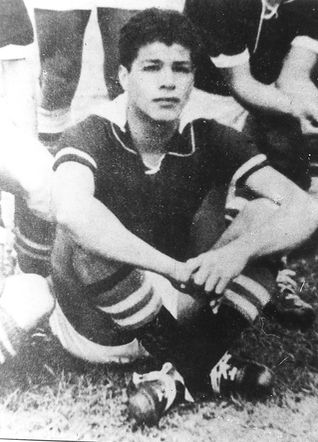
Just three years after his debut, "Fello" Meza emerged as the most prominent figure in the Old Metropolis (this is how the Carthaginian is known) and obtained the title of Costa Rica's national scorer in 1940 with 13 scores, a despite having played only nine games, due to an injury. Several international series came at the end of the championship, in which he participated, either defending the colors of the Carthaginian or the other teams and national teams that asked for reinforcement. One of those series was against Estudiantes de la Plata de Argentina, who scored three goals in three games. The Argentines wanted to hire “Fello” immediately, but the national football leadership declared it non-transferable by virtue that the First Central American and Caribbean Football Championship was about to be played. In that contest he had an outstanding participation that led Costa Rica to the title unbeaten. That role catapulted Meza to international football, intended by teams such as Mexico's America, but it was finally the Moctezuma de Orizaba also from Mexico who would serve for 200 dollars a month. He left on June 22, 1941, a day after he married Nydia with Lydia Montoya. In his debut in the Aztec lands he was a scoring champion with 21 goals in 12 games, and then travel south, heading to Argentina in October 1942, hired by Estudiantes de la Plata. There he remained two seasons again reaching high praise by converting 18 and 15 entries in 1942-43 and 1943-44 respectively. In 1944 "Fello" returns to Costa Rica but leaves again to Mexico hired by the Moctezuma, with which he achieves another 21 goals in 1945. The following season he went to the Atlantean, who paid $ 10,000 for his card, a very high figure at that time. With the "others" he would reach the Mexican championship in the 1946-47 season, and 35.36 and 32 goals in the three seasons with the Catalans. In 1949 he returned to Moctezuma for a few months. There he got another 19 goals and ended his experience in Mexico with a high production of 163 goals. That same year "Fello" returned to Costa Rica. After a short break he left for Colombia to play the 1950-1951 season with the University of Bogotá where the kneecap was injured. He could only act in 8 games for a production of 8 goals. That injury forces him to return to Costa Rica, where he was in recovery for six months. He then joined the Carthaginian where he served a double role as a player and coach, an experience that had already been entrusted to him in his second stage with the Moctezuma. In 1953 "Fello" traveled to Honduras where he completed his last international experience in two stages, also making them a player and coach in the Tela Customs team, this happened when he had already renewed with the blue and white team, which is why the Carthaginian Directive agreed the expulsion of the player for five years. (http://www.teletica.com/Noticias/16639-Hoy-8-de-julio.note.aspx) “Fello” ended his successful and memorable career with the Herediano Sport Club, a team he played with and He won the 1955-1956 championship. Meza, died on June 15, 1988. As a tribute to the greatness of this player, the Carthaginian Sport Club baptizes its stadium with the name of José Rafael "Fello" Meza Ivancovich on August 2, 1973, during an international triangular in the The Liverpool of Uruguay, Herediano and the CSCartaginés participated. José Rafael Meza Ivancovich is considered, along with Alejandro Morera Soto, as the greatest player in the history of Costa Rican football.
TOP 11:
Rónald "La Bala" Gómez Gómez
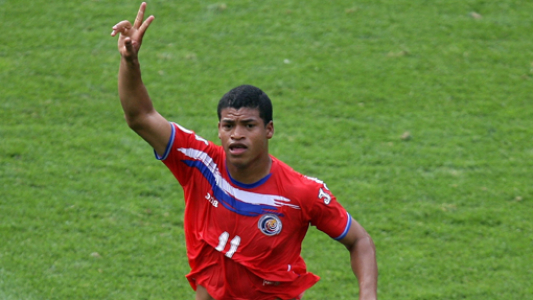
He debuted in the First Division of Costa Rica in 1992 at AD Carmelita, a team with which he had two outstanding campaigns. That was worth passing, in 1994, to LD Alajuelense, a club with which he established himself as a footballer, winning both the 1996 championship and being the top scorer of the season with twenty-seven goals. This led to his departure to the international arena, being hired in 1996 by Real Sporting de Gijón de España. Later, he played with Hercules CF, the Municipal CSD of Guatemala and the OFI Crete of Greece between 1997 and 2003. Upon returning to Costa Rica, in 2004, he was hired by Deportivo Saprissa, a team with which he won four national championships and one Concacaf Champions League and, individually, won the Boot and the Ballon d'Or in 2005. He also played in the Club World Cup 2005, where he finished in third place after São Paulo FC and Liverpool FC. abroad: one to Kuwait football and another to Cyprus football. In 2008, he ended his contract with Saprissa, retiring from football to coach Carmelita in the 2009 Summer Championship, unable to avoid the team's descent.3 For the 2009 Winter Tournament Gómez formalized, at thirty-four, his He returned as a player with Santos de Guápiles, recently promoted to the Costa Rican First Division, although after a few months he finally retired to start directing to that same club for almost a year until he was fired.5 Since 2012, he occupies the bench of AD Escazuceña, team of the Second Division of Costa Rica. He was international with the Costa Rican national team on 91 occasions, scoring twenty-four goals. He played the 2002 and 2006 World Cups, in which he scored three goals that place him as the Costa Rican and Central American player who has scored the most goals in the history of the World Cups.
TOP 10:
Álvaro Alberto Saborío Chacón
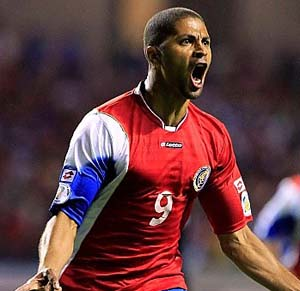
Saborio began his professional career at Deportivo Saprissa in Costa Rica in 2001.1 He has played in European leagues (Switzerland, and England in Second Division). He currently counts several goals in MLS with Real Salt Lake as well as many others in the Concacaf Champions League tournament placing him as the historical scorer of his team. With Saprissa he was part of the team that played the FIFA Club World Cup 2005, in which he finished in third position. He scored two goals and finished tied with 3 more players as top scorer of the tournament.2 In 2006 he signed for FC Sion of Switzerland. He has been international with the Costa Rica Soccer Team. He debuted in 2002 and so far has scored 32 goals in 64 games.5 He has also been international with the U-23 team, with which he scored the goal that qualified Costa Rica for the 2004 Athens Olympics. In the games he played 4 games, scoring somewhat against Portugal which meant qualifying for the quarterfinals against Argentina.
TOP 9:
Evaristo Coronado Salas
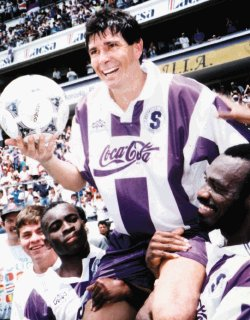
Throughout his First Division career he played with Deportivo Saprissa. His beginnings in football were with the University of Costa Rica in the Second Division. In 1981 he arrives at Deportivo Saprissa, where in his first season as a professional he manages to be a scorer of that year's championship with 23 goals. To the goal title of that year we must add that of 1988 with 19 goals. In addition, he was the best scorer for Saprissa in the 1981, 1985, 1987, 1988 and 1992 seasons. His maximum was to be the Saprissa player with the most goals made for this institution in its history with a total of 181. he remembers his 100th goal in the First Division, achieved in 1989 against Municipal Puntarenas (1-1). He joined the Costa Rican National Team between 1983 and 1992 scoring 10 goals in 52 games. His main goals with the selected Costa Rican major were against Honduras in 1983 (2 goals in the 3-2 victory at the 1984 Los Angeles Olympiad), against Egypt at the Los Angeles Olympics in 1984, he scored the victory goal against States United in 1985 that allowed Costa Rica to advance in the 1986 World Cup qualifier and in the 1990 Italy qualifier he scored the goal of the victory against Guatemala (2-1) and that of the draw against Trinidad de Tobago (1-1) . However, he could not be part of the Costa Rican National Team that participated prominently in the 1990 World Cup in Italy. He was known as The Soccer Knight for his safe play and the respect he had for his opponents. He never received a direct red card, but was expelled for an arbitration error later admitted by the same referral. Coronado helped Saprissa win five national titles, in 1982, 1988, 1989, 1994 and 1995, the year of his retirement from professional football. He was also part of the Saprissista team that won the first CONCACAF Champions Cup in 1993. Evaristo Coronado retired from football in the 1995 season. His farewell match was staged on August 27, 1995 in a match between Saprissa and the Communications from Guatemala. That day Ricardo Saprissa Stadium turned 23 years old. Among the curious aspects in Evaristo Coronado's career is the fact that he never converted a penalty goal, failing three throughout his career. Also, without being prepared for it, he was coach of Saprissa at the end of the 2001 season, with a poor work of the purple team, which was going through economic difficulties at that time. In 2002 he was the main candidate for deputy of San José by the First National Party, obtaining 12718 votes, insufficient figure to win the seat. Today Coronado serves as a Civil Engineer and serves as an advisor to the Board of Directors of Deportivo Saprissa.
TOP 8:
Javier “Zurdo” Jiménez Baez
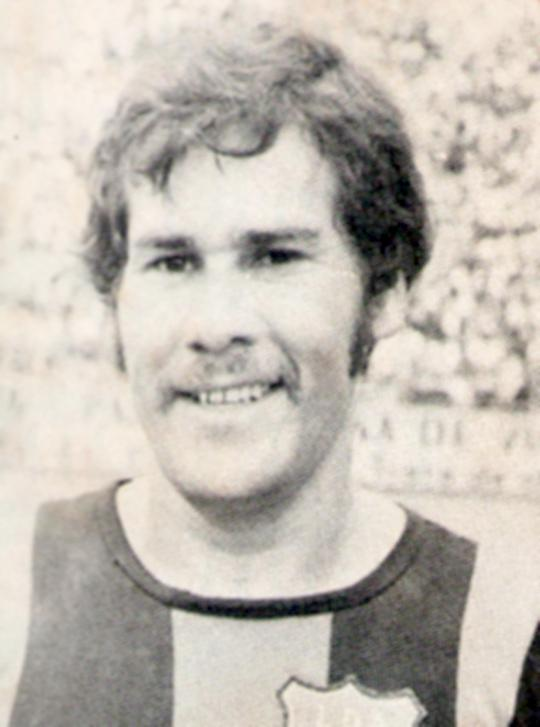
The Stadium was filled to enjoy its game, colorful, cheerful and of great quality where it brought many joys to the red and black fans. “One of the most formidable extremes the country has had. A clean, colorful, dribbled game, with a hobby that loved him and applauded him standing up, ”says the book Memory of the Alajuelense Sports League written by Armando Morux Sancho in 1995. For 12 years he wore the red-and-white shirt being part of the teams that obtained the national championships of 1980 and 1983, playing as a left pointer. On eight occasions he was summoned to the Major National Team where he registered a total of 30 meetings with the major. A part of the military with LDA he played with Carmen, Guanacaste and Real España de Honduras. In the one against one, there was no one like the "Left-handed" and together with Alejandro González he was a great protagonist in obtaining the scepter of 1980.
TOP 7:
Hernán Evaristo Medford Bryan
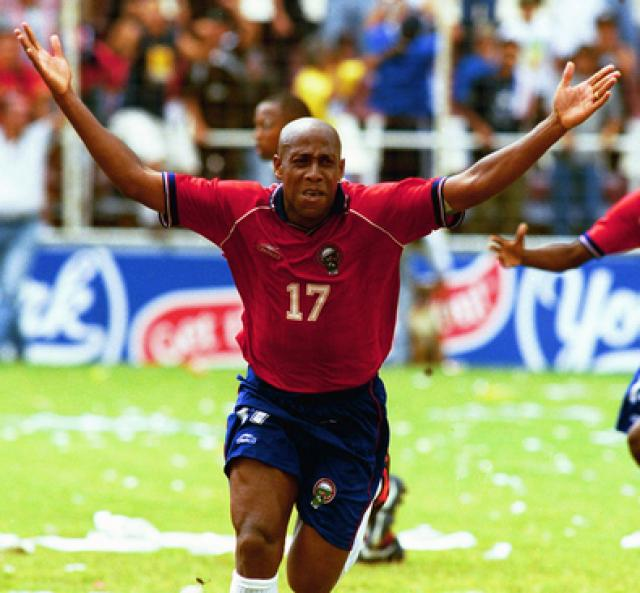
As a player he started in the Sagrada Familia and Deportivo Saprissa of Costa Rica. Later, he was hired in Europe, where he played in Calcio Italiano with the US Foggia, in Spain with Rayo Vallecano, in Austria with Rapid Vienna, in Croatia (then Yugoslavia) with NK Dinamo Zagreb, and then in the League Mexicana, before passing through First A, where he was a fundamental pillar of Pachuca to achieve promotion to the first division there, he became one of the biggest players in the league, being his number 17 retired to realize his 100th goal for life, He also played for Necaxa and Leon. Chosen as the player of the 90s in Costa Rica. It should be noted that he also played the 1985 China World Children's Championship, where he would score Costa Rica's only goal in that competition (Costa Rica 1: 4 Saudi Arabia) and the first goal in a FIFA World Cup from the junior to senior category. He was a member of the Costa Rica soccer team that qualified and played the World Cup in Italy 90, where he scored Costa Rica's second goal against Sweden (Sweden 1: 2 Costa Rica).
TOP 6:
Errol Daniels Hibbert
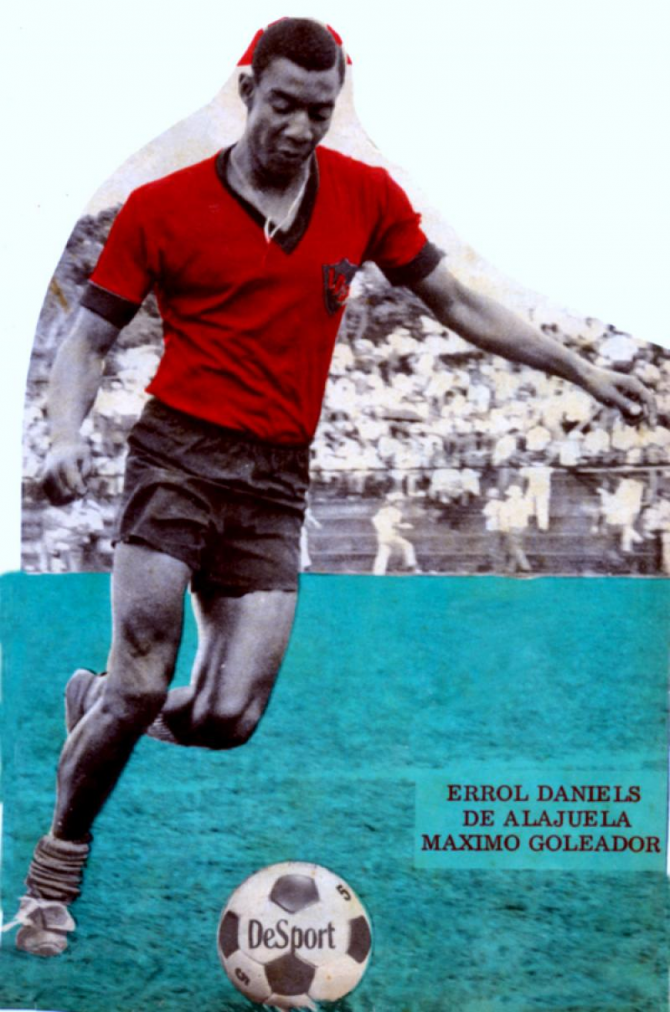
He was an outstanding Costa Rican footballer, who held until 2013 the record of being the historic scorer of Costa Rican football with 196 goals. His strengths were his explosive speed and his fierce shot. Daniels debuted at age 21 on June 14, 1964 against the Carthaginian, scoring 2 goals. He began to play as a left-back forward, because the central forward position was occupied by another historic player, Juan Ulloa. He was the top scorer of the First Division in 6 seasons (1964, 1965, 1966, 1967, 1968 and 1970). Daniels is the top scorer of all time in the league with 196 goals. He scored 41 goals for Liga Deportiva Alajuelense during the 1967 season. He scored 24 goals in 1964, 32 in 1965, 30 in 1966, 41 in 1967, 23 in 1968, 16 in 1969, 25 in 1970 and one in 1971 and 1972. Also He won the national tournament with his team in 1966, 1970 and 1971. He suffered an injury on April 14, 1971. The season had just begun and in the second game he hit the Mexico City goalkeeper, fracturing his right leg. He returned on June 25, 1972 against San Carlos, and scored his last goal on September 17 of the same year against Municipal Puntarenas.
TOP 5:
Joel Nathaniel Campbell Samuels
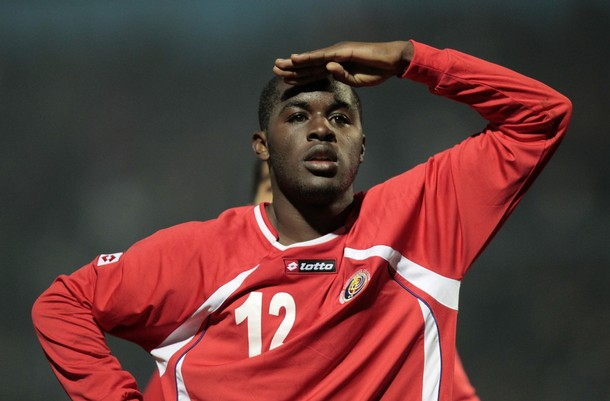
Campbell was chosen in the Costa Rican national team for the U-17 Soccer World Cup in 2009, he was the team's top scorer, scoring two goals in total. He was called in 2011 to form the national team in the Concacaf U20 Championship of 2011 two years later scoring six goals. He officially debuted with the senior team of Costa Rica on June 5, 2011, in the Gold Cup scoring a goal. After the Copa América, the team of the Arsenal Football Club of England offered a contract to Campbell, however the player's father, who is also his manager, decided to wait for the signing of the contract until after finishing the U-20 World Championship so that the player could concentrate on the work of the National Team; Once the championship ended with an outstanding performance: two goals and three assists to his credit, he accepted and signed the contract with the English team.
TOP 4:
Francisco "Chico" Hernández Ramírez
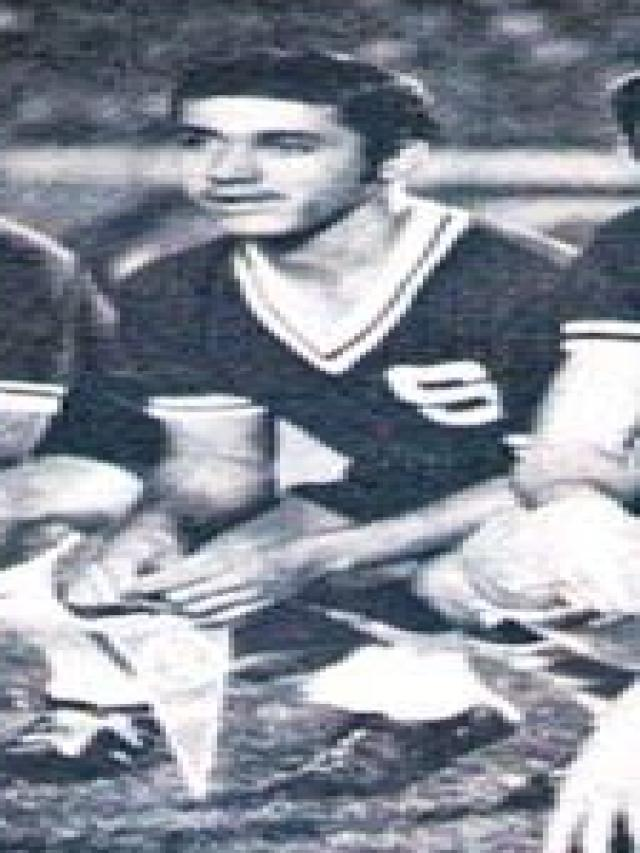
Short gambeta, who liked the low and precise game and the “a pot” centers, came to Deportivo Saprissa in 1963, in the mosquito category, thanks to the efforts of Víctor Bolaños. When he played center forward, he held the privilege positions among the best scorers of each year, during his journey through the minor leagues of the purple team. In 1967, coach Mario Catato Cordero joined him in the First Division. Then, Argentine strategist José Ramos gave him his chance and Chico did not miss it. With only 17 years he was already a member of the First Division of Saprissa. In that campaign he became the right wing of the club and scored 12 goals. Two years later he was already an idol of the purple hobby, according to Pastor's review. Francisco played in the top category for 16 seasons and won 10 championships (six in a row). As selected, he dressed the Tricolor in 31 class A matches and scored five goals, between 1967 and 1980, when he was the captain of the Olympic Games in Moscow. He left football on November 27, 1983.
TOP 3:
Rolando Fonseca Jiménez
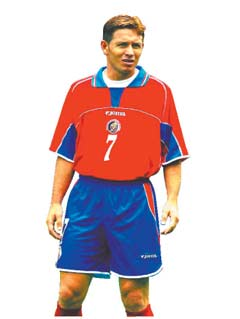
He is a former Costa Rican footballer. I played as a forward. The Ticos classify him as one of the best Costa Rican players. He has been international with the Costa Rican National Team and has been the biggest gunner of the national team, with 47 goals currently. He played the UNCAF Cup of Nations in El Salvador, a tournament in which he reached the figure of 100 games played with the national shirt, when his team faced the local team. In it, he scored the second goal of the victory of the Costa Rica Soccer Team (2-0). This goal makes him the top historical scorer of the Costa Rican National Team with 46 goals at that time, and the historic scorer of that tournament with 19 goals. In addition to contesting 5 eliminatory processes to world football cups (1994-2010). In 2007, he was consolidated as the top gunner of the national team and playing against Chile managed to score the 1000th goal in the history of the Costa Rican national team, his greatest joy.
TOP 2:
Paulo César Wanchope Watson
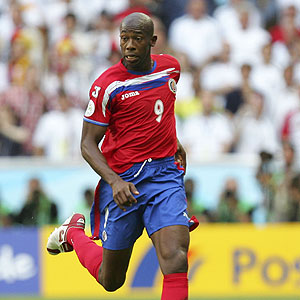
It started at Club Sport Herediano, in Costa Rica. Then, along with Mauricio Solís, he was hired at Derby County FC in England. In that country he was also in West Ham United and Manchester City. His first goal in the FA Premier League was scored by Manchester United to goalkeeper Peter Schmeichel. Wanchope was the second Latino to score in the history of English football surpassed only by the Uruguayan attacker Bonet. Then he went to Malaga of Spain. From 2005 he played in the Al-Gharrafa of Qatar football. In the Costa Rican soccer team he was a key player for years, scored 21 goals in the tie and scored 45 goals with the Costa Rican shirt. In the final hex of the 2006 Germany tie he scored goals for Mexico and Guatemala. In addition, in the opening match of this World Cup he scored two goals for Germany adding 3 since in the World Cup South Korea / Japan 2002 he scored for the Brazil team. In July 2006 he signed for Rosario Central of the Argentine First Division, where he converted five goals, one in the Rosarino Classic against Newell's Old Boys. Once the Argentine Tournament ended, he dissociated himself from the rogue team since the coach, Néstor Gorosito, was not going to take it into account at that time and joined the Tokyo FC of Japan on December 29, 2006 signing a contract until 2008. On 30 June terminated the contract with FC Tokyo. After his departure, a month later he signed with the Chicago Fire. On November 16, 2007, Wanchope announced his retirement from professional football due to physical knee problems. On January 13, 2008, he retired with the national team of Costa Rica, playing 32 minutes in a friendly match against Sweden at the Ricardo Saprissa Stadium. On January 16, 2008, he retired with the Herediano Sport Club, playing an official match of the 2008 Summer Tournament. With this, he began and concluded his sports career at that institution.
TOP 1:
Alejandro Morera Soto
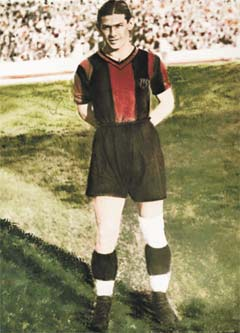
He was a Costa Rican soccer player, who played as a striker for most of his career for Liga Deportiva Alajuelense of the First Division. He was a fast forward, with good reflexes and with an intuition of the play, always timely, which allowed him to anticipate the action of the strong defenses of that time. "The Costa Rican Phenomenon" was the nickname given by newspapers in Catalonia, Spain, when he was part of FC Barcelona that won the Catalunya championship in 1934. He was also known in Costa Rica as "The Magician of the Ball". Morera Soto was short, 1.65 m with a small but powerful foot of size 35. He was a power forward, who played at a high level in the 1933-34 season, ”he also informed La Nación (Costa Rican newspaper) Manuel Tomàs Belenguer, in charge of the Documentation and Studies Center of FC Barcelona. "As regards what the Hercules of Alicante paid for Morera, in the Barcelona sports newspaper" El Mundo Deportivo "on July 12, 1935, it was reported that Hercules had paid 10,000 pesetas to FC Barcelona for Morera. This figure came confirmed by two executives of the Alicante club ". In statements given in 1973 by Morera to the newspaper El Mundo Deportivo, (12/21/1973, page 13) his best memory of the time was the game he played as part of the Catalan national team against the Brazilian national team during a visit of the South Americans to Barcelona. There Morera scored the goal of the Catalan triumph 2 goals to 1. A few days later FC Barcelona faced the Brazilians again, who after the first half won by a score of 4 to 0. In the second half the Catalans traced the difference by drawing finally the game at 4 goals with Morera scoring 2 of the goals. In its first season with the Hercules of Alicante the team managed to occupy the sixth position of the league championship with the same number of points as FC Barcelona, who obtained the fifth place for best average goals. In that season Morera scored 9 goals. In July 1936 the civil war broke out in Spain while Morera visited Hungary with two of his teammates, the Hungarian Emil Berkessy and Mario Cabanes. This trio of players and friends was known in football of the time as "The Three Musketeers Azulgrana". Because the war had begun to ravage Spain, he preferred not to return so that he could not withdraw his savings from the bank. He decided to hide the money he had left in a chest, then for his bad fortune this chest was lost. Given the urgent need to return and lacking money, he had to play two games with the French team Le Havre AC and thus obtain the money needed to return. He arrived in Costa Rica on November 2, 1936 continuing his career, again, with Liga Deportiva Alajuelense and later with Liga Deportiva Alajuelense he would win another championship in 1939 scoring three goals in the final against Club Sport Herediano. He obtained the title again in 1941 (setting a record when he managed to champion undefeated) and then in 1945, both as a player and as a technical director. His last game as a player was on April 6, 1947 wearing the colors of the Alajuelense Sports League against Municipal Lima. He continued as a coach until March 7, 1949. After his retirement he was elected Deputy to the Legislative Assembly by Alajuela (1958-1962) and was also Governor and Municipal President of Alajuela.

